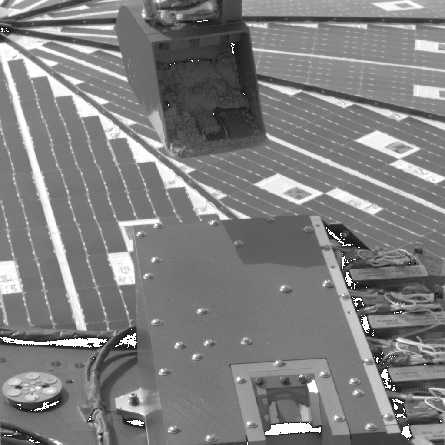Shake, shake, shake
Phoenix Lander's vibrators get Martian soil sample into instrument's oven
- More than 2 years ago
Seven rounds of shaking later, the Mars Phoenix Lander finally got some soil into one of its tiny ovens.

The Phoenix science team instructed the robotic lander to deliver a scoop of dirt to the oven, which is part of the Thermal and Evolved-Gas Analyzer instrument, or TEGA, on June 6 — 12 days after Phoenix successfully landed on the Red Planet’s arctic plains. But the soil was too clumpy to fall through the sieve, which covers the oven and is designed to strain out larger chunks from the more fine-grained dirt.
“This soil is unlike anything we tested Phoenix with on Earth,” said the mission’s principal investigator Peter Smith during a NASA press briefing Wednesday. “It’s crusty and clumps into balls and sticks to the side of sloped metal surfaces.”
For the past few days, the lander’s science team has been scrambling to redesign digging commands in response to the news that the soil sample delivered to oven number 4 did not initially strain into the TEGA instrument as planned. The work-around, Smith said, was to come up with he called the salt-shaker or sprinkler method.
Mission scientists used a vibrator on the instrument to shake the soil. The goal was to break up the particles so they slid through the oven sieve’s 1-millimeter-by-1-millimeter squares and into the oven for testing. Off and on, TEGA co-investigator William Boynton instructed the instrument to vibrate back and forth for a few seconds to a few minutes at a time.
“Last night we ran the vibrator for a seventh time,” said Boynton of the University of Arizona in Tucson. “We had not expected it to work.”
But when the scientists received data back from the lander Wednesday morning, they learned that the program sent to command the shaking had terminated early. That usually happens if something malfunctions, but “we looked at the data and the fact was that dirt finally did start to flow,” Boynton said. “We did get a full oven.”
The news came just after the team had relayed up the lander’s commands for the following day, June 12. So not until the next scheduled communication can the team instruct the TEGA oven to close its doors and begin baking the newly acquired sample. Boynton said the team may have preliminary results Friday, but full analysis of the 30-milliliter sample will take at least a week.
If everything goes well, the scientists could have their first microscopic look at the Martian soil as early as Thursday, June 12, Smith added. He said the commands sent on June 11 instructed the robotic arm to capture a soil sample for the optical microscope in one of the lander’s other instrument’s, the MECA, or Microscopy, Electrochemistry, and Conductivity Analyzer.
The optical microscope can collect data about the sizes, shapes and magnetic properties of the Martian soil particles; distinguish different mineral grains; and determine the individual soil particles’ colors.
The microscopic views will provide the Phoenix team members the first clues about the composition of the Martian dirt around the lander. Something is missing in the mixtures scientists use on Earth to model the soil found in this region of Mars, Smith added, and “I am quite anxious to figure out what it is.”
Later, TEGA and MECA wet chemistry instruments will analyze how much water or ice is in the soil, its mineral content and what exactly makes the soil samples so clumpy.
“Without the data, our ideas are not much more than guesses,” Boynton said. But with a full oven, the team knows they can now make more than guesses. That why the scientists took a few minutes to cheer and dance to the ’70s favorite “(Shake, Shake, Shake) Shake Your Booty” Wednesday when Boynton announced the good news about filling a TEGA cell.
From now on, “shake, shake, shake” will be normal procedure: The robotic arm, Smith said, will scoop the material and, with its crank, hold the sample in the scoop at a steady angle and vibrate it by running the motorized rasp located beneath the scoop. This “thumper,” as Smith calls the rasp, was originally designed to scrape at the Martian surface. Now, it will help the arm gently jostle some material out of the scoop to the target below.
“It’s like putting flour in a sieve,” Smith said. “Sometimes you have to bang on it to get it to go through,” but then the soil will come down in a “rain of particles.” The trick is to get that soil rain over the entry point and ensure that enough of it gets into the instrument, he added.
Should the method be equally successful delivering samples to the lander’s microscope, the team will position the robotic arm to dig more trenches in and take more samples from a spot dubbed Wonderland.
Watch an animation of the robotic arm sprinkle soil onto the Phoenix Lander’s instruments:







